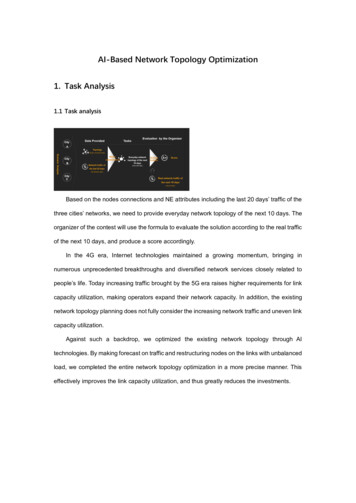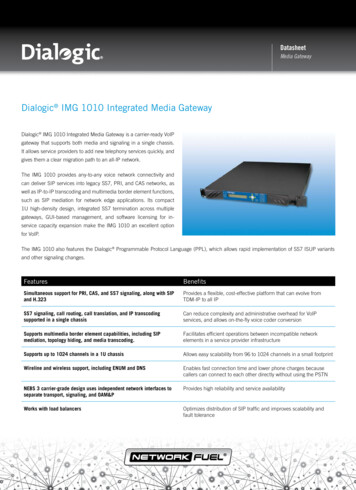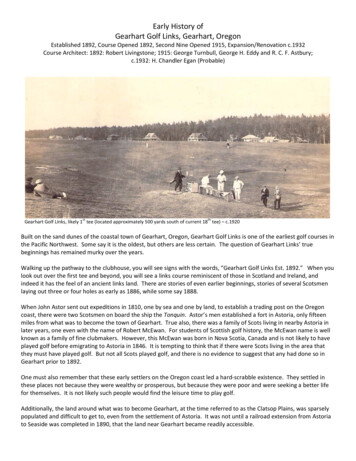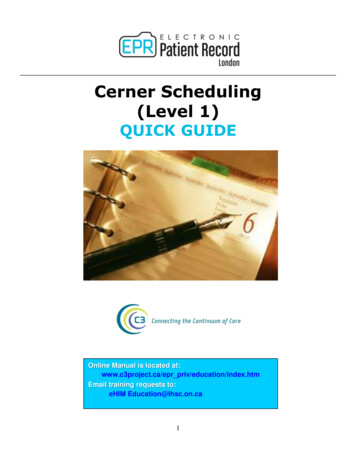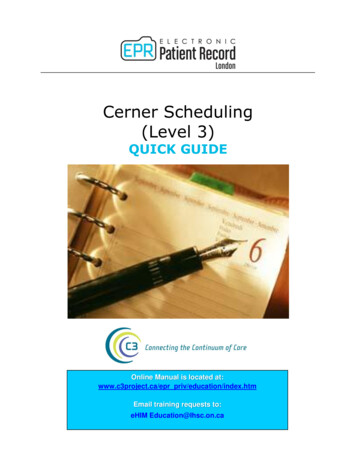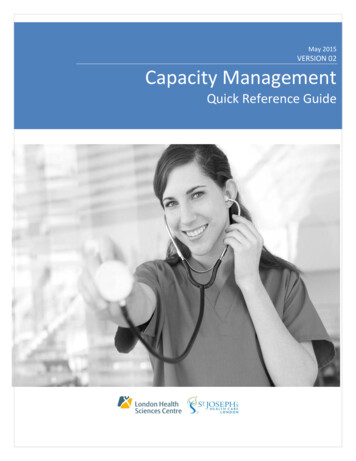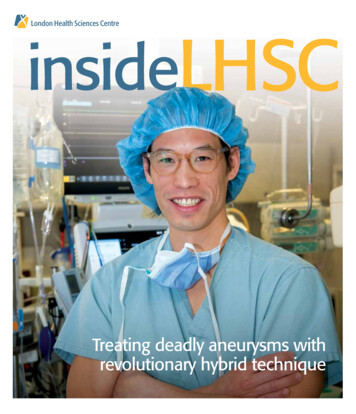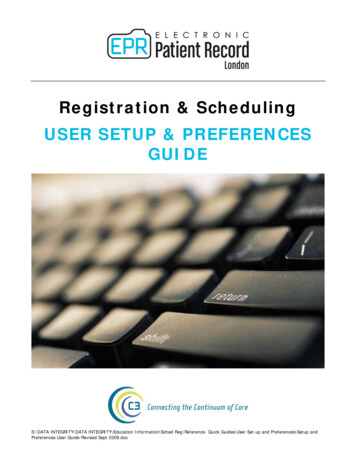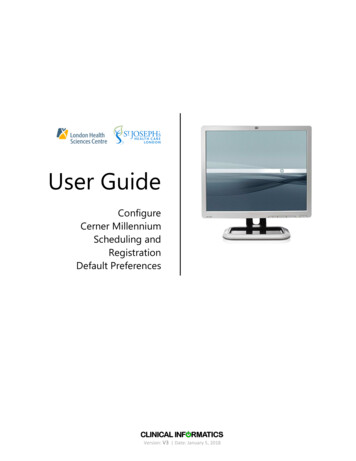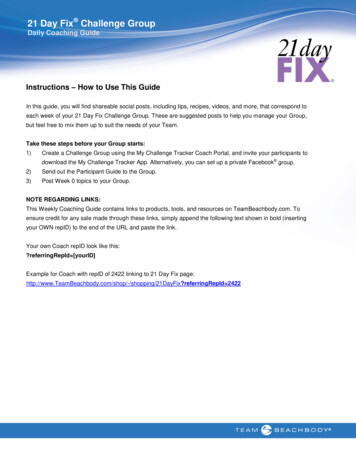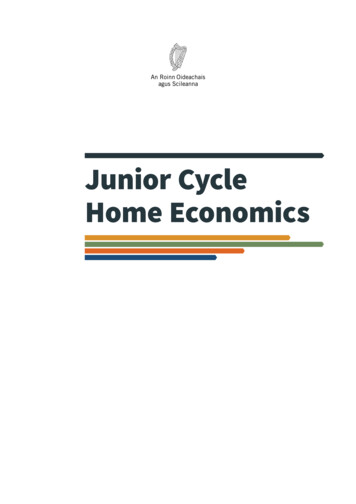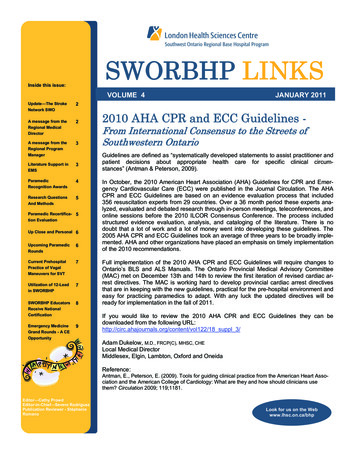
Transcription
SWORBHP LINKSInside this issue:VOLUME 4Update—The StrokeNetwork SWO2A message from theRegional MedicalDirector2A message from theRegional ProgramManager3Literature Support inEMS3ParamedicRecognition Awards4Research QuestionsAnd Methods5Paramedic Recertifica- 5tion EvaluationUp Close and Personal 6Upcoming ParamedicRounds6Current PrehospitalPractice of VagalManeuvers for SVT7Utilization of 12-Leadin SWORBHP7SWORBHP EducatorsReceive NationalCertification8Emergency MedicineGrand Rounds - A CEOpportunity9JANUARY 20112010 AHA CPR and ECC Guidelines -From International Consensus to the Streets ofSouthwestern OntarioGuidelines are defined as “systematically developed statements to assist practitioner andpatient decisions about appropriate health care for specific clinical circumstances” (Antman & Peterson, 2009).In October, the 2010 American Heart Association (AHA) Guidelines for CPR and Emergency Cardiovascular Care (ECC) were published in the Journal Circulation. The AHACPR and ECC Guidelines are based on an evidence evaluation process that included356 resuscitation experts from 29 countries. Over a 36 month period these experts analyzed, evaluated and debated research through in-person meetings, teleconferences, andonline sessions before the 2010 ILCOR Consensus Conference. The process includedstructured evidence evaluation, analysis, and cataloging of the literature. There is nodoubt that a lot of work and a lot of money went into developing these guidelines. The2005 AHA CPR and ECC Guidelines took an average of three years to be broadly implemented. AHA and other organizations have placed an emphasis on timely implementationof the 2010 recommendations.Full implementation of the 2010 AHA CPR and ECC Guidelines will require changes toOntario’s BLS and ALS Manuals. The Ontario Provincial Medical Advisory Committee(MAC) met on December 13th and 14th to review the first iteration of revised cardiac arrest directives. The MAC is working hard to develop provincial cardiac arrest directivesthat are in keeping with the new guidelines, practical for the pre-hospital environment andeasy for practicing paramedics to adapt. With any luck the updated directives will beready for implementation in the fall of 2011.If you would like to review the 2010 AHA CPR and ECC Guidelines they can bedownloaded from the following URL:http://circ.ahajournals.org/content/vol122/18 suppl 3/Adam Dukelow, M.D., FRCP(C), MHSC, CHELocal Medical DirectorMiddlesex, Elgin, Lambton, Oxford and OneidaReference:Antman, E., Peterson, E. (2009). Tools for guiding clinical practice from the American Heart Association and the American College of Cardiology: What are they and how should clinicians usethem? Circulation 2009; 119;1181.Editor—Cathy ProwdEditor-in-Chief—Severo RodriguezPublication Reviewer - StéphanieRomanoLook for us on the Webwww.lhsc.on.ca/bhp
VOLUMEPAGE42Update — The Stroke Network SWORemember thismnemonic:FfaceAarmSspeechTtimeThe new 2010 Stroke Best Practice Guidelineshave just been released. Information is available in an easy-to-search and smart-phonefriendly website www.strokebestpractices.ca.The website includes resources to improvestroke and emergency services and to measure their effectiveness. Check it out.Use of a standardized stroke diagnosticscreening tool by EMS responders has beenrecommended to increase sensitivity of identifying potential stroke patients on scene, especially those who may be candidates for timesensitive interventions such as thrombolysisusing tissue plasminogen activator (tPA). TheCincinnati Prehospital Stroke Scale (CPSS)is a three-item scale based on a simplificationof the National Institutes of Health (NIH)Stroke Scale. It uses the mnemonic, FAST(Face, Arm, Speech, Time), for rapid identification of stroke and transient ischemic attacks. This scale was found to have good validity in identifying patients with stroke who arecandidates for thrombolytic therapy, especiallythose with anterior circulation stroke.Stroke patients have up to 4.5 hours from theonset of their symptoms or “last seen well” topossibly be treated with clot busting (tPA)drugs. Paramedics working in the province ofOntario will soon be able to transport morepeople who suffer a sudden onset of strokesymptoms to the designated stroke centre sothat they can receive thrombolytic therapy(tPA). The revised Paramedic Prompt Card iscoming soon.Remember, Time is Brain.On behalf of the Stroke Network of SWO Iwould like to wish you all a very happy 2011and thank you for the hard work you do everyday to increase the value of life for stroke patients. It really makes a difference.Janet LiefsoAcute Stroke CoordinatorStroke Network SWOVitals are like.vitalFor years, I have been stating the annoying obvious fact that vital signs are just that: vital. If theyweren’t so important (in fact vital), we would call them optional signs and say things like “Hey,good idea in not checking the blood pressure.” But we don’t. If you do, perhaps we should meet.Soon.“.the monitormay be able toascertaincertain criticalpieces ofinformation ”Recently, incredibly, I found myself in court at a Coroner’s Inquest stating these exact words to ajury and a team of lawyers during my nine hours on the witness stand. This should never havehappened. My opinion in this very complicated case was that the paramedics involved documented a dramatically abnormal life threatening vital sign, on two occasions, then opted not to provide treatment since the patient “looked” so well. In essence, they discounted the thirty thousanddollar piece of equipment that was beeping loudly telling them that the patient was unwell. Instead,they decided that the monitor must be wrong since the patient “looked” so well. He later died.The argument against my position was that paramedics are taught “treat the patient, not the monitor”. This global statement is reasonable when you have a talking patient who looks well and amonitor that shows ventricular fibrillation or asystole. Clearly this can’t be correct and I agree—inthose cases—treat the patient. However, it is possible that the monitor may be able to ascertaincertain critical pieces of information (in fact vital pieces of information) that your “look” may not beable to provide you. Otherwise, why even bother having the machine in the first place? Why don’twe just send you out there to have a good “look” at the patients and see what you think? But wedon’t. And we shouldn’t.What I am saying is this.don’t be looking for reasons NOT to treat patients. Use every piece ofinformation available to you to find something that you may be able to address or correct, then doeverything you can to bring the patient to the hospital.Maintaining that vigilance is what makes you, a vital link in the chain of survival.Michael Lewell, B.Sc., M.D., FRCP(C)Regional Medical Director
VOLUME4PAGE3Where do I Stand?Are we waiting for Godot? More importantly, are you waiting for Godot? That is, are you waiting for someone to summarize the evidence of why we do what we do in the prehospital environment, or do you seek it out via publications in peerreviewed journals? Sadly, many wait endlessly, then rely on the summaries of others for information we should seek outourselves. The reasons for waiting are numerous but often reflect self-created boundaries based on lack of experience,fear, or motivation to grow. Many waited for Godot, postulating endlessly as to why and when their wait would end, sadlynever seeking a solution nor taking action to discover why. So again, I would ask not are you waiting, but why are youwaiting?Wang, E., Lave, J., Sirio, C., Yealy, D. (2006). Paramedic Intubation Errors: Isolated Events or Symptoms of Larger Problems? HealthAffairs 25(2), 501-509.Vrostsos, K., Pirrallo, R., Guse, C., Aufderheide, T. (2008). Does the Number of System Paramedics Affect Clinical BenchmarkThresholds? Prehospital Emergency Care 12(3), 302-306.Whyte, B., Ansley, R. (2008). PAY FOR PERFORMANCE IMPROVES RURAL EMS QUALITY: Investment in Prehospital Care. Prehospital Emergency Care 12(4) 495-497.Colwell, C., Mehler, P., Harper, J., Cassell, L., Vazquez, J. (2009). Measuring Quality in the Prehospital Care of Chest Pain Patients.Prehospital Emergency Care 13(2) 237- 240.Olasveengen, T., Sunde, K., Brunoborg, C., Thowsen, J., Steen, P., Wik, L. (2009). Intravenous Drug Administration During Out ofHospital Cardiac Arrest: A Randomized Trial. Journal of the American Medical Association. 302 (20) 2222-2229.Austin, M., Wills, K., Blizzard, L., Walters, E., Wood-Baker, R. (2010). Effect of high flow oxygen on mortality in chronic obstructivepulmonary disease patients in prehospital setting: Randomised controlled trial. British Medical Journal, 341:c5462.Eschmann, N., Pirrallo, R., Audfderhide, T., Lerner, E. (2010). The Association between Emergency Medical Services Staffing Patterns and Out-of-Hospital Cardiac Arrest Survival. Prehospital Emergency Care 14(1) 71-77.Lee, C., Van Gelder, C., Cone, D. (2010). Early Cardiac Catheterization Laboratory Activation by Paramedics for Patients with STsegment Elevation Myocardial Infarction on Prehosptial 12-Lead Electrocardiograms. Prehosptial Emergency Care 14(2) 153-158.Severo Rodriguez, B.A., M.Sc., NR-LP, AEMCARegional Program ManagerReferences:Beckett, S.(Writer), Blin, R.(Director) (1953). Waiting for Godot. NY, Grove Press.Drucker, P. (2010). Managing Oneself. 10 Essential Reads [Special Article Collection]. HBR (Original work published in 1999).Literature Support in EMSAs an educator, I am often asked for the ‘why’ behind the direction of our medical directives, and I must say that this is avery refreshing question. It is finally nice to see paramedics wondering why we do what we do, and not simply the ageold saying: “because our protocols say so”. The answer to this question comes very simply from primary literature in thefields of emergency medicine and EMS. Literature searches are conducted on a daily basis at SWORBHP and are anexhaustive and systematic search for published work on a specific topic, and for further application to the field of EMS.Essentially, we want to use research conducted by credible researchers to influence or support the medicine we practice, and thus creates evidenced based EMS medicine.Literature searches are conducted by SWORBHP in an attempt to fill the gaps in EMS research. So what exactly doesthis mean? SWORBHP is actively engaged in advancing EMS not only in Southwest Ontario, and not only Canada-wide,but across North America. Our recent literature searches in the field of pre-hospital 12-lead ECG acquisition, test itemreliability and validity, and paramedic competence have led us to conduct our very own research. This research has ledto the acceptance of five of our abstracts by the NAEMSP (National Association of EMS Physicians) Scientific Assemblyfor presentation in January 2011; something we are all extremely proud of!So what does all of this mean for the future of EMS? Aside from the rumour-ridden world we work in, have a look back tothe past ten years of EMS. Things have changed drastically, have they not? I can say reassuringly, that with the supportof our Regional Medical Director, the team at SWORBHP, and our dedication to evidence based medicine, the changesare far from a stagnant halt. EMS is a young and progressive culture of which you the paramedic will be an integral part.Stéphanie Romano, HBSc., A-EMCA, NCEERegional Paramedic EducatorLook for us on the Webwww.lhsc.on.ca/bhp
VOLUME4PAGE4Paramedic Recognition AwardsParamedic Recognition Awards were introduced in 2010. Several paramedics were recognizedlast year for their accomplishments. Congratulations to the following paramedics:Medical DirectorsAward ofExcellencePrehospitalSaveAwardPrehospitalNewborn DeliveryAwardTristan Barter, Huron County EMS was awarded the Medical Directors Award of Excellence inrecognition of leadership and participation in educational activities above and beyond regularclinical responsibilities.Nick Leclerc, Essex-Windsor EMS was awarded the Medical Directors Award of Excellence inrecognition of outstanding clinical judgment and actions during a difficult clinical scenario.The following paramedics were recognized for a Prehospital Save:Grey County EMS—Darren Clock, Andrew MurrayHuron County EMS—Dave Wagner, Harold MartinEssex-Windsor EMS—Ljubisa Apostolovski, J.P. Bacon, Mike Basinski, Brittany Bianchet,Brian Boismier, Jeff Borghi, Jacey Brockman, David Cakebread, Andy Closs, Hannah Colenutt,Brandon Damm, Vic Dimitriu, Ziad Fatallah, Troy Gee, Mike Gobet, Mona Hansen, Bradley Hart,Gerry Hedges, Sean Hettrick, Peter Hilliker, Jeff Huber, Rob Injic, Tony Jaroszewicz,Shannon Johnston, Nisreen Karkanawi, Ryan Kreeft, Tom LeClair, Ashley Lemay, Doug Litster,Nathan MacMillan, Michael Manery, Michella Mollicone, Andre Mongeau, Pete Morassutti,Mechelle Murphy, Dawn Newman, Marty Petro, Shaun Rivard, Randy Rollo, Prentice Scott,Rick St-Pierre, Paul Stromme, Don Theriault, Amy VanCowenberg, Angela Volpatti,Michelle Wilkinson, Michael YeboahThames Middlesex EMS—Paul Keane, John BlaauwThe following paramedics were recognized for a Prehospital Newborn Delivery:Huron County EMS—Don DolmageEssex-Windsor EMS—Doug Bryant, Ryan Kreeft, Kenard Silver, Matthew OadesParamedics Honoured at AMEMSO ConferenceSeveral paramedics received awards at the annual AMEMSO Conference held in Huntsville thispast September.Governor General’sExemplary ServiceMedalN.H. McNallyAward forBraveryThe Governor General’s Exemplary Service Medal recognizes paramedics who performed theirduties in an exemplary manner, denoting at least 20 years of meritorious service. Paramedicswho received this award are:Bruce County EMS—Steve Schaus, R. Douglas SmithChatham-Kent EMS—Paul Patterson (Posthumous), accepted by his parents Wayne and Clara.Essex-Windsor EMS—Diane Clark, Elwood Defour, Pete Hilliker, Garry Long, Tim McDonald,Ed SchererGrey County EMS—Murray Adams, Peter Shaw, Leonard Smith (retired)Lambton County EMS—Ray Gowan, Tony SteadmanPerth County EMS—Mike Grosz, Julie JeffreyThames EMS (Elgin)—Carla MacArthur, Tasha McCaig, Tim McFaddenThames EMS (Middlesex)—Dale Blanchard, Gary Pinnell, Dan TyoThe N.H. McNally Award recognizes on-duty paramedics for acts of bravery, acknowledgingthose individuals who went above and beyond the line of duty to protect others from harm.Receiving the N.H. McNally Award for Bravery were:Bruce County EMS—William Ernest and Darryl HopcraftThe Southwest Ontario Regional Base Hospital Program would like to congratulate all awardrecipients for their outstanding accomplishments.Cathy Prowd, CQIATeam Leader, Operations & Logistics
VOLUME4PAGE5Research Questions and MethodsResearch is a way of producing evidence to be able tomake claims about the truth of something.Good research starts with a specific question the researcher wants to answer. The type of question and howit is asked determines the method the researcher uses toanswer the question. Different methods are developed toanswer different types of questions.The Evidence Based Medicine (EBM) movement hasbeen influential in shaping how medical research is done.EBM defines a “hierarchy of evidence” based on themethod used to produce it. This has been misinterpretedto mean that some methods of research are ‘better’ thanothers.The ‘clinical trial’ has become the dominant style of producing evidence for therapeutic effectiveness. However,clinical trials are limited in the type of evidence they produce. The ‘randomized controlled trial’ (RCT), a specifictype of clinical trial, is regarded as the gold standard forclinical research. While RCTs might be able to prove ordisprove some types of therapeutic claims, they are severely limited by and dependent upon the question asked.They are not able to answer questions that ask howsomething works or why it works.For example, a question might be; in patients with a bloodsugar of 2mmol/L, do more patients have a blood sugar 5mmol/L 10 minutes after receiving 25mls of 50% dextrose IV or 1mg of Glucagon IM? This type of question isbest answered by performing a randomized control trial.However, if the researcher was interested in how a treatment affects the patient’s quality of life, a different question would be asked. For example, when you have a hypoglycaemic reaction, which method of treating it do youprefer, D50 IV or Glucagon, and why? In this situation,interviewing a series of patients or perhaps using a questionnaire would be appropriate methods for determiningthe answer.Both are interesting questions but the method used to findthe answer is completely different. One method is not‘better’ than the other; they are just different and suited todifferent questions the researcher wants to ask.Don Eby, M.D., M.Sc., CCFP(EM) FCFPLocal Medical DirectorGrey, Bruce, Huron and PerthParamedic Recertification EvaluationThe process used for the 2010-2011 paramedic recertification written test included two significant changes; it wascompleted in-class without the use of resource materials,and the answers were not reviewed with learners at thecompletion of the test. Why did we have these changes?Written tests can be used for two purposes; to continuethe learning process, or as a formal evaluation for the purpose of certification. In past recertification courses, writtentests were used as a learning tool, often by issuing it precourse and by reviewing the marked tests in-class. Thisprocess does enhance the learning experience, but it generally eliminates the test questions from re-use.This year, it was decided to use the written test as a formal evaluation, but a higher stakes evaluation requireshigher standards for defensibility of the test. First, extensive work was completed to properly create each question. Then, as described in the October 2010 edition ofSWORBHP LINKS, we used the modified-Angoff processto establish the cutscore (pass mark). To date, we haveeight-hundred PCP tests and just over one-hundred ACPtests completed, with nearly two-hundred more PCP testsand approximately fifteen more ACP tests to come. Onceall services have completed the written test, each questionwill be analyzed for several factors to determine the reliability and validity of each test question. In essence, weare evaluating the test to confirm the value and precisionof each question. Questions that do not meet the established standards are either revised or discarded entirely.Those that meet the standards are entered into a databank for future use, providing full confidence that thequestions have proven themselves to be of high value.The disadvantage to this process is that learners are notallowed to see their specific errors and do not knowwhere they went wrong. However, planning is alreadyunderway for a webinar in April 2011 that will address allcommon issues found from the written test without specifically reviewing the questions and answers themselves. This will ensure that the written test providescontinued learning for everyone.David Vusich, ACP, A-EMCA, AdEd, NCEEEducation CoordinatorLook for us on the Webwww.lhsc.on.ca/bhp
VOLUME4PAGE6Up Close and PersonalIn this edition of LINKS, we will take you up close and personal with Tracy Gaunt, StéphanieRomano and Brenda Smith Huie. We hope this allows you an opportunity to get to know each ofthem a little better.Tracy Gaunt, B.A, NCEE, CQIAProfessional Standards SpecialistTracy joined SWORBHP in January 2009 as a full-time Regional Paramedic Educator andrecently accepted a new position as a Specialist in Professional Standards. She holds anHonours Bachelor of Business in Emergency Services Management from Lakeland Collegeand is a recent graduate of the Council for Licensure, Enforcement and Regulation’s Investigator program. She is currently completing her Master of Science degree with a major in Instructional Design and Technology through Walden University. Tracy is a part-time paramedicin Bruce County. Tracy and her husband Bill live in Port Elgin with their daughter Tara andtheir new puppy Ella.Stéphanie Romano, HBSc., AEMCA, NCEERegional Paramedic EducatorStéphanie joined SWORBHP in January 2010 as a full-time Regional Paramedic Educator.She holds an Honours Bachelor of Science as a Human Biology Specialist from the Universityof Toronto and a diploma in Paramedicine from Centennial College. Stéphanie is currentlycompleting her Master of Science in Global Higher Education through Walden University. Sheteaches Anatomy, Physiology, Therapeutic Communication and Gerontology at FanshaweCollege and is a part-time paramedic in Elgin County. In the past, she worked as a ProgramConsultant for Health Sciences & Human Services at Fanshawe College. Stéphanie and herhusband Pat live just west of London with their Rottweiler-Shepherd Boston, and their fourcats. Stéphanie and Pat are expecting their first baby in April.Brenda Smith HuieTeam Assistant, Professional StandardsBrenda has been with the Base Hospital since 1998, initially as Data Entry Clerk for the London Base Hospital. In September 2008 she joined SWORBHP as a Customer Support/Receptionist. Brenda is currently Team Assistant for Professional Standards. As a practicingShaman and Naturalist outside of work, Brenda likes to integrate these skills in the workplace.Environmental awareness, compassion, positive energy and kindness are just some of theanecdotes that play a role in her daily activities. Brenda is the “frontline” of SWORBHP and isoften the pleasant voice you will hear when you call the London office.Upcoming Paramedic RoundsJanuary 31, 10:00 a.m. - Live Rounds and Webinar - MCIFebruary 9, 2:00 p.m. - Webinar - Sports InjuriesLook for us on the WebFebruary 18, 10:00 a.m. - Webinar - ECC Updateswww.lhsc.on.ca/bhpMarch 7, 9:00 a.m. - Webinar - AnaphylaxisMarch 18, 10:00 a.m. - Webinar - Prehospital 12-Lead ECGLate March - Webinar - Prehospital Care of Tracheostomy PatientsEarly April - Webinar - Lessons Learned - 2010/11 Recertification ReviewLate April - Webinar - Blast InjuriesVisit our website and view the special page dedicated to upcoming CE opportunities.http://www.lhsc.on.ca/About Us/Base Hospital Program/CME Opportunities.htm
VOLUME4PAGE7Current Prehospital Practice of Vagal Maneuvers for SVTThere is still a role for Vagal maneuvers in SVT. The current version of our protocols allows for these maneuverswith stable narrow complex, regular tachycardias, whererapid atrial fibrillation and atrial flutter have been excluded. The protocol allows for two attempts of 10 to 20seconds per attempt, and the Vagal maneuver defined isa Valsalva maneuver (Advanced Life Support PatientCare Standards, June 2007).stopping the arrhythmia. In addition, when the maneuver isstopped there is a sudden increase in preload when theblood is now allowed to return, which stretches the rightatrium and conduction system, and drops the heart rate,sometimes stopping the SVT about 10 to 20 seconds afterthe maneuver is finished.This is in no way to be confused with carotid massage,which is specifically contraindicated in the protocols,unless advised by a Base Hospital Physician (whichThere are two Valsalva maneuvers. The classicThere is stillhopefully will not happen) (Advanced Life Supportone involves pinching the nose while expiring witha role forPatient Care Standards, June 2007). The carotidthe mouth closed to force air into the EustachianVagalmassage can lead to CVA (Adlington et al, 2009),tubes and middle ear. Many of us have done thismaneuversretinal artery occlusion, and transient confusionwhile flying or diving in order to recover our hearingin SVT.(Munro et al, 1994). Research shows there is reallyfrom the pressure effects. This is not the best formno advantage in using carotid massage over theof the Valsalva to use in cardiac cases. Rather weValsalva Vagal maneuver, they can both be effective 10 toneed the modified version where we take a big breath20% of the time (Lim et al, 1998).and push down like delivering a baby or having a bowelmovement. This can be assisted by placing your hand onPaul Bradford, B.Sc., M.D., CCFP(EM), FCFP, CDthe patient’s abdomen and asking them to push it up withLocal Medical Directortheir abdominals while expiring against the closed glottis.Essex-Windsor, Chatham-KentThis maneuver increases the heart rate and forces bloodout of the chest and into the carotid sinus stretching it andReferences:Advanced Life Support Patient Care Standards, June 2007 Version 2.1, Advanced Medical Directives for ACPs, Appendix 2, pg. 2-8Adlington et al, Carotid sinus massage: Is it a safe way to terminate supraventricular tachycardia? Emerg Med J 2009;26:459Munro et al, Incidence of complications after carotid sinus massage in older patients with syncope. J Am Geriatr Soc. 1994 December;42(12):1248-51Lim et al, Comparison of treatment of supraventricular tachycardia by valsalva maneuver and carotid sinus massage, Ann EmergMed January 1998;31:30-35Utilization of 12-Lead in SWORBHP12-Lead is an important tool for local paramedics to improve care delivery in the setting of cardiac ischemia. We knowthat 12-lead is helpful in ER physician treatment decisions (Davis et al, 2011) and that outcomes can be improved if usedin concert with ASA and transport to percutaneous coronary intervention (Myers et al, 2008).Over a 15 month period (January 2009 to March 2010), PCPs working in Essex, Middlesex and Oxford Counties, used12-lead in 2,740 cases. Of those 2,740 uses: 993 were followed by ASA only, 172 were followed by Nitro only, and 923 had both ASA and Nitro administered.652 received a 12-lead with no other cardiac ischemia treatment. This approach can be appropriate as long as patientsare not excluded from care based on the result of their 12-lead. Many patients suffering from cardiac ischemia have normal electrocardiograms, hence the maxim: ‘treat the patient, not the monitor’. The most obvious avoidable risk of 12-leaduse is that it can extend scene time. In order to have greatest utility, the 12-lead and a living patient must reach the receiving physician, so risk-benefit has to be balanced.ASA and Nitro administration can also have risks. Paramedics have demonstrated considerable aptitude in proper application of the cardiac ischemia protocol. Of 1,165 cases where either ASA or NTG were withheld, only 13 (0.1%) errors inapplication of the protocol were identified. This is an incredible achievement given the complexity of the directive. .cont’d on pg. 8
VOLUME4PAGE8Utilization of 12-Lead in SWORBHP - cont’dReminders:1. PCPs are very accurate with applying their cardiac ischemia medical directive. Cases resulting in error were usually because the reason for withholding an intervention was not documented. Please make sure your ACR documentation supports your decision making.2. 12-lead is an important tool in the setting of ischemic chest pain to assist in sequestering patients towards percutaneous coronary intervention (either directly through bypass protocols orindirectly through the ER) and reducing door to needle time.3. Quality 12-lead is important to improve diagnostic use, so try to keep artifact to a minimum byhaving patient remain still. If quality is poor, consider re-doing.4. In the case of patients with severe hemodynamic compromise, emphasis on treating the patient’s A, B and C supersedes the 12-lead and this may be deferred or performed only whenthere is no impact on scene time and you have free hands.5. There were 24 cases where 12-lead was interpreted as MI, but only 20 were coded as ‘57Myocardial Infarction’, and of those coded as 57, only 12 had supporting 12-lead evidence ofMI. When your 12-lead interpretation includes STEMI, please code the final problem as 57and if no STEMI is identified on 12-lead, do not use this code.Paul Robinson, ACP, AEMCAProfessional Standards SpecialistTracy Gaunt, B.A., NCEE, CQIAProfessional Standards SpecialistAdeel Ahmed, M.Eng, CQETeam Leader, Professional Standards & Performance ImprovementReferences:Myers, J., Slovis, C., Eckstein, M., Goodloe, J., Isaacs, S., Loflin, J., Pepe, P. (2008). Evidence-Based Performance Measures for Emergency Medical Services Systems: A Model for Expanded EMS Benchmarking, Prehospital Emergency Care;Apr-Jun 2008, 12(2):141-151. doi:10.1080/10903120801903793.Davis, M., Dukelow, A., Lewell, M., McLeod, S., Rodriguez, S., (2011). The Utility of the Prehospital Electrocardiogram inthe Emergency Department, (Abstracts for the 2011 National Association of Emergency Medical Services Physicians Scientific Assembly), Prehospital Emergency Care;15:104–137(Abstract 113). doi: 10.3109/10903127.2010.525298SWORBHP Educators Receive National mmitment tothe higheststandards ofeducationalprogram designand delivery”.Five Educators at the Southwest Ontario Regional Base Hospital Program recently attainedNationally Certified EMS Educators (NCEE)status, becoming the first to do so outside ofthe United States. The two hour certificationexam was administered at the London, Ontariooffice of SWORBHP by Laura Krawchyk, Education Coordinator for the National Associationof EMS Educators (NAEMSE), acting on behalfof the National EMS Educators CertificationBoard.Dwayne Cottel, Tracy Gaunt, Peter Morassutti,Stéphanie Romano, and David Vusich join theranks of only 160 EMS Educators whohave completed the requirements for this certification to date. All five completed the 40 hourNational Association of EMS Educators(NAEMSE) Level 1 Instructor course earlier in2010, a pre-requisite for writing the certificationexamination.In addition, Stéphanie and David attended thenew 30 hour NAEMSE Level 2 Instructorcourse as part of the pilot group, providingfeedback that helped to shape the program thatis now available to EMS Educators.“ C o n gr a t u la t i o nstoourC an a d i anEMS colleagues at the Southwest Ontario Regional Base Hospital Program for being the firstintern
Regional Program Manager 3 Literature Support in EMS 3 Paramedic . That is, are you waiting for someone to summa-rize the evidence of why we do what we do in the prehospital environment, or do you seek it out via publications in peer . Paramedic Intubation Errors: Isolated Events or Symptoms of Larger Problems? Health Affairs 25(2), 501-509 .
